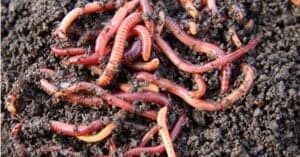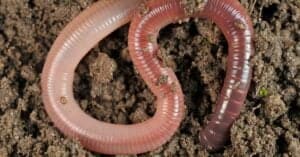Annelids are incredible creatures that are extremely diverse. The term “annelid” describes a large group that includes over 22,000 species! Unfortunately, we cannot learn about all of them in one sitting, but this article will discuss 5 particularly notable species. Read on to discover 5 types of annelids and where they live.
Background
Taxonomy
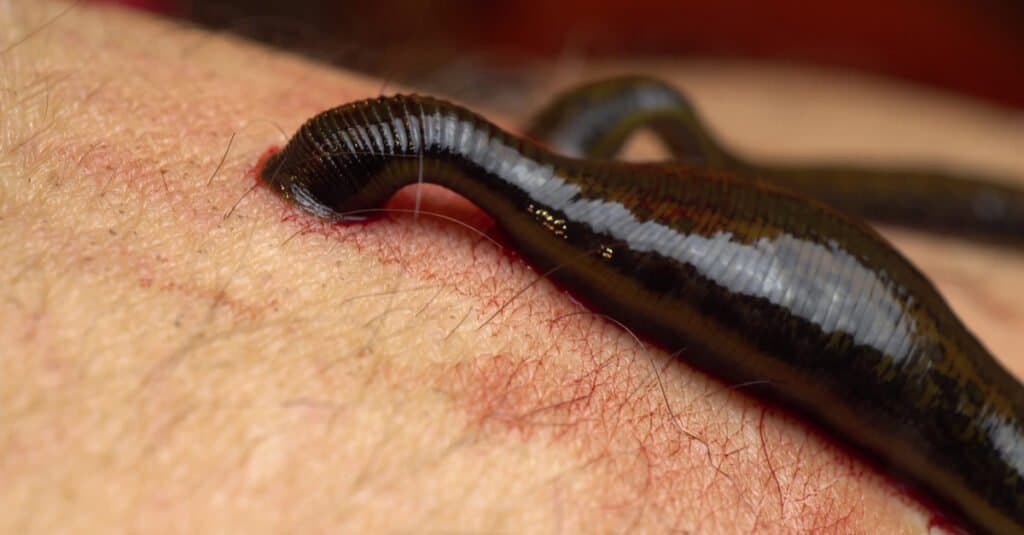
Leeches are a type of annelid that are parasitic.
©Vital9s/Shutterstock.com
The phylum Annelida, often referred to as annelids, constitutes a diverse group of segmented worms with a rich evolutionary history. Annelids are classified under the Lophotrochozoa superphylum, a lineage of protostome animals that includes mollusks, brachiopods, and other worm-like phyla. The phylum Annelida is characterized by its segmented body plan, with each segment typically possessing its own coelom and associated structures, such as setae or bristles for locomotion.
The evolutionary relationships within Annelida are still the subject of ongoing research and debate. Molecular phylogenetic studies have provided valuable insights into the relationships among the subgroups and the evolutionary history of annelids. It’s important to note that the taxonomy and understanding of annelid diversity continue to evolve as scientists uncover new species, and as more genetic data become available for analysis. However, despite the ongoing refinements in our understanding of annelid phylogeny, this phylum remains a fascinating and integral part of the animal kingdom, showcasing the complexity of life’s evolutionary journey.
Annelids can be broadly categorized into three major subgroups: the Polychaeta, Oligochaeta, and Hirudinea. These subgroups differ in their morphology, lifestyle, and habitat preferences.
Polychaetes
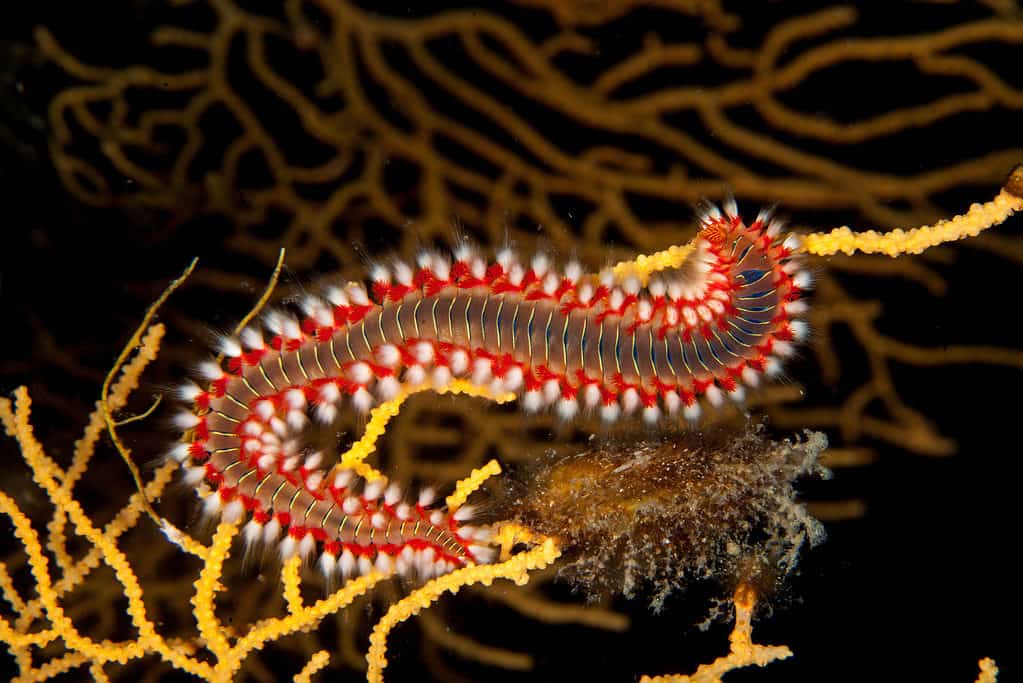
The bearded fireworm, a polychaete, has several white bristles with venom.
©Gerald Robert Fischer/Shutterstock.com
Polychaetes are the largest and most diverse subgroup within the Annelida phylum, with over 10,000 known species. They are primarily marine worms and are often highly adapted to various ecological niches. Many polychaetes have complex, paddle-like parapodia covered in setae, which they use for both locomotion and respiration. Some notable examples of polychaetes include the colorful and feathery fan worms and the predatory bobbit worms.
Oligochaetes
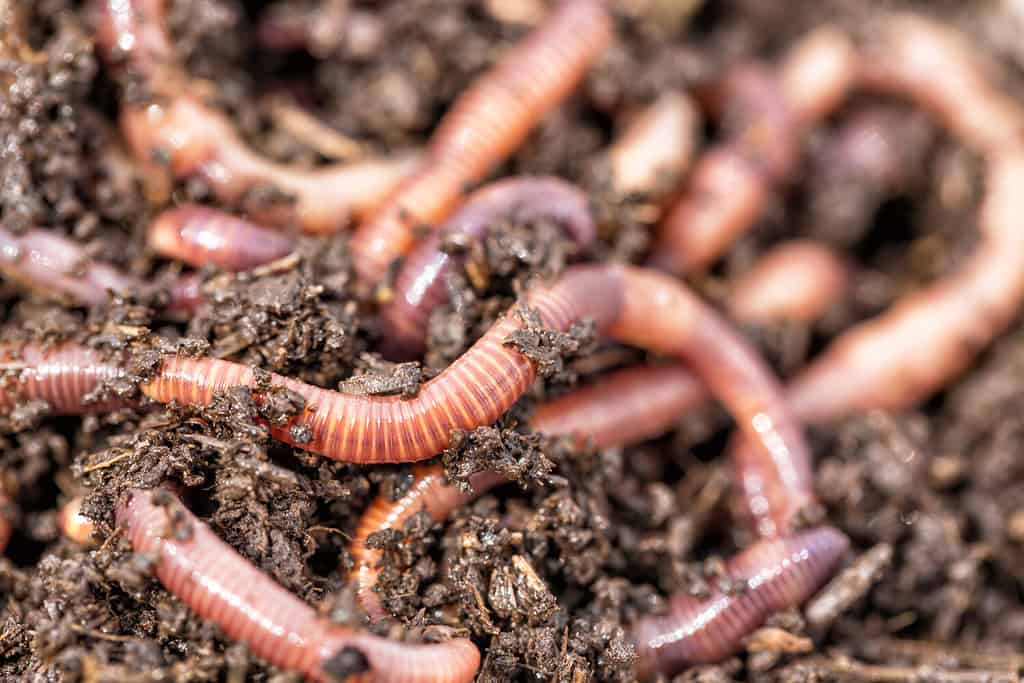
Common
earthworms
are oligochaetes.
©Nick N A/Shutterstock.com
Oligochaetes are primarily terrestrial or freshwater worms and are less diverse in terms of species. They have fewer, less specialized setae and lack parapodia. The common earthworm (Lumbricus terrestris) is a well-known example of an oligochaete. Oligochaetes play a vital role in soil health and ecology, as they help decompose organic matter and improve soil structure.
Hirudinea
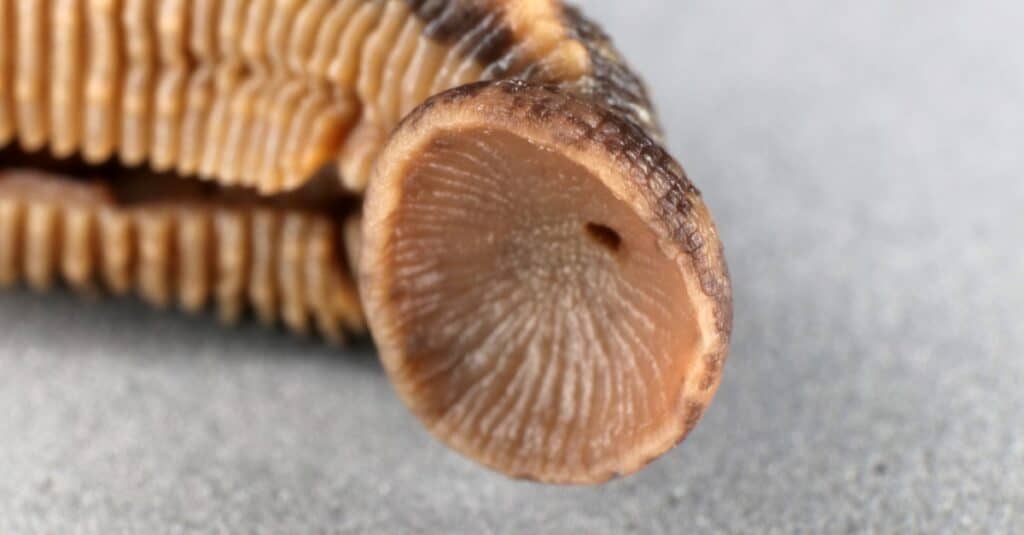
The European medicinal leech (
Hirudo medicinalis), among other medical leeches, was in high demand during the 19th century when blood-letting was a common medical practice.
©photowind/Shutterstock.com
Hirudinea, commonly known as leeches, are perhaps the most familiar subgroup of annelids. Leeches have fewer segments, and their bodies are often flat. They typically inhabit freshwater environments, although some species can thrive in terrestrial habitats. Leeches are infamous for their blood-feeding behavior and have been used for medicinal purposes and, historically, in bloodletting procedures.
Biology
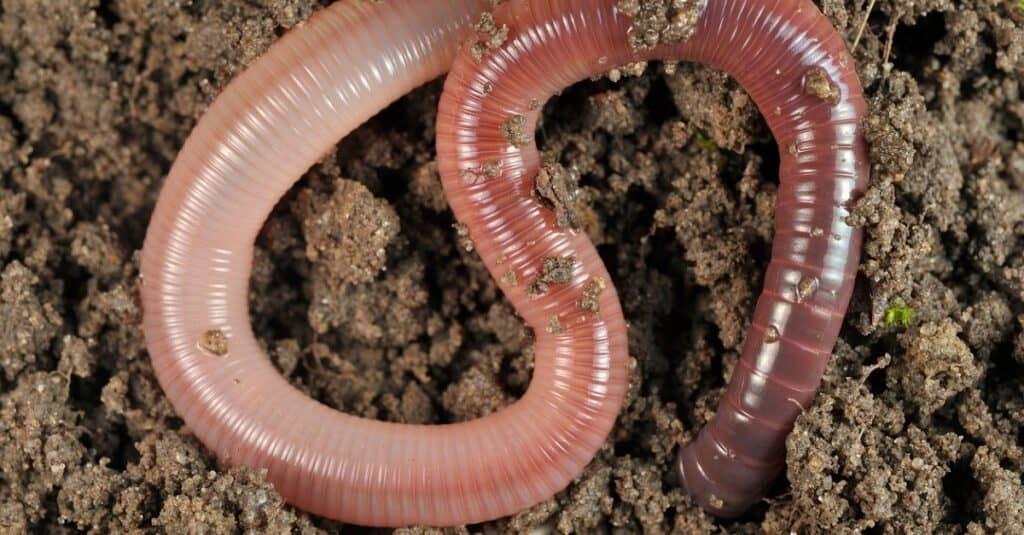
A characteristic trait of annelids is a segmented body, exemplified here by a common <a class=”wpil_keyword_link” href=”https://a-z-animals.com/animals/earthworm/” title=”
earthworm
.
©iStock.com/K-Kucharska_D-Kucharski
A segmented body plan characterizes annelids. Each segment often possesses its own coelom, a fluid-filled body cavity that surrounds the internal organs. This segmentation allows for flexibility and specialization of body parts within each segment, allowing for various functions. Most annelids have bristles or setae on their bodies. They use these appendages for locomotion, providing grip and facilitating movement through their environments. Annelids possess a complete digestive system with a mouth, pharynx, esophagus, and intestine. Their diets can range from filter feeding, herbivory, and carnivory to detritivory, depending on the species.
Furthermore, they typically have a closed circulatory system. A dorsal blood vessel functions as the heart, which pumps blood throughout the body. Annelids also have paired excretory organs called nephridia in most segments, responsible for waste removal and osmotic regulation. Respiration methods vary among annelids. Some have specialized respiratory structures like gills or some engage in gas exchange through their skin. Annelids exhibit various modes of reproduction, including both sexual and asexual methods, with sexual reproduction involving the release of eggs and sperm into the environment.
Annelids exhibit a wide range of adaptations and specializations in their diverse lifestyles, which encompass marine, freshwater, and terrestrial habitats. They can be free-living or parasitic, with ecological roles that include filter feeding, burrowing, scavenging, predation, and more. Their well-developed nervous system, featuring a simple brain or cerebral ganglion and paired nerve cords along the ventral side of the body, allows them to sense and respond to their environment. While these traits are generally characteristic of annelids, there can be exceptions and variations within the phylum due to their remarkable diversity and adaptability.
#1 African Giant Worm
The African giant worm, or Microchaetus rappi, is a remarkable annelid species. What sets this worm apart from its annelid relatives is its truly impressive size and distinctive morphology. These massive earthworms average 6 feet long and can be up to 22 feet long, making them one of the largest annelids in the world. Their bodies are a unique cylindrical shape with smooth, shiny skin. This is unusual for earthworms. Unlike the common earthworms often found in garden soil, the African giant worm is not segmented externally presenting a more streamlined appearance. Their size and unique morphology distinguish them as a notable example within the diverse phylum of annelids.
Where Do They Live?
African giant worms predominantly inhabit the lush and tropical regions of sub-Saharan Africa. These colossal annelids live in a variety of terrestrial habitats. Their habitats include dense rainforests, moist savannas, and the banks of freshwater bodies such as rivers and streams. They have a strong preference for areas with high humidity and rich organic content in the soil. The ecological role of African giant worms as soil engineers is particularly vital in these habitats. This is because they burrow deep into the earth, aiding in soil aeration, nutrient cycling, and water filtration. The African giant worms’ contribution to maintaining healthy soil ecosystems is most pronounced in their favored tropical environments, where their unique adaptations have allowed them to thrive and play a significant role in the ecological balance of these regions.
#2 Giant Amazon Leech
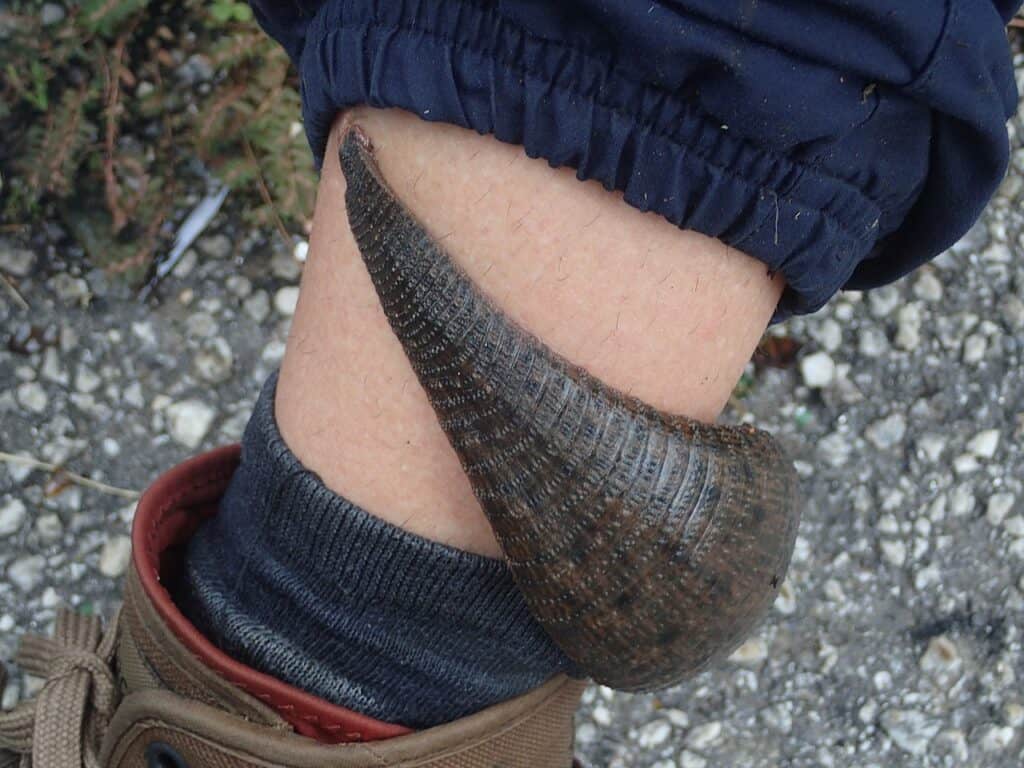
The giant Amazon leech is a parasite that voraciously feeds off its host.
©Anonyme973 / CC BY-SA 4.0 – License
The giant Amazon leech, Haementeria ghilianii, is a remarkable annelid species with impressive size and distinctive features. This leech is one of the largest in the world, with individuals reaching lengths of up to 18 inches or more. Its body is long and flat, sometimes sporting a striking pattern of bright yellow bands on a dark brown background.
Unlike many other leeches, the giant Amazon leech is a predatory species. Its mouthparts feature a unique set of jaws that allow it to slice through the skin of its host and feed on the blood. What sets this leech apart among annelids is its formidable hunting behavior and preference for large vertebrate hosts, including mammals and birds. Found in the freshwater habitats of the Amazon rainforest and other South American regions, the giant Amazon leech plays a unique role in the ecology of its environment.
Where Do They Live?
Giant Amazon leeches primarily inhabit the Amazon rainforest and its associated freshwater habitats in South America. Their geographic range includes countries such as Brazil, Venezuela, Colombia, and parts of other Amazonian regions. These leeches are well adapted to life in the wet, tropical environment of the Amazon basin.
These leeches have a strong preference for aquatic habitats. They commonly live in slow-moving or stagnant water bodies, such as swamps, ponds, and small streams within the rainforest. They are often associated with submerged vegetation and decaying organic matter. These leeches are particularly skillful at clinging to submerged plants and waiting for potential hosts to swim by, as they are primarily blood-feeding parasites that attach themselves to mammals and birds when the opportunity arises. Their specialized adaptations and habitat preferences reflect their unique ecological niche in the Amazon rainforest ecosystem.
#3 Pile Worm
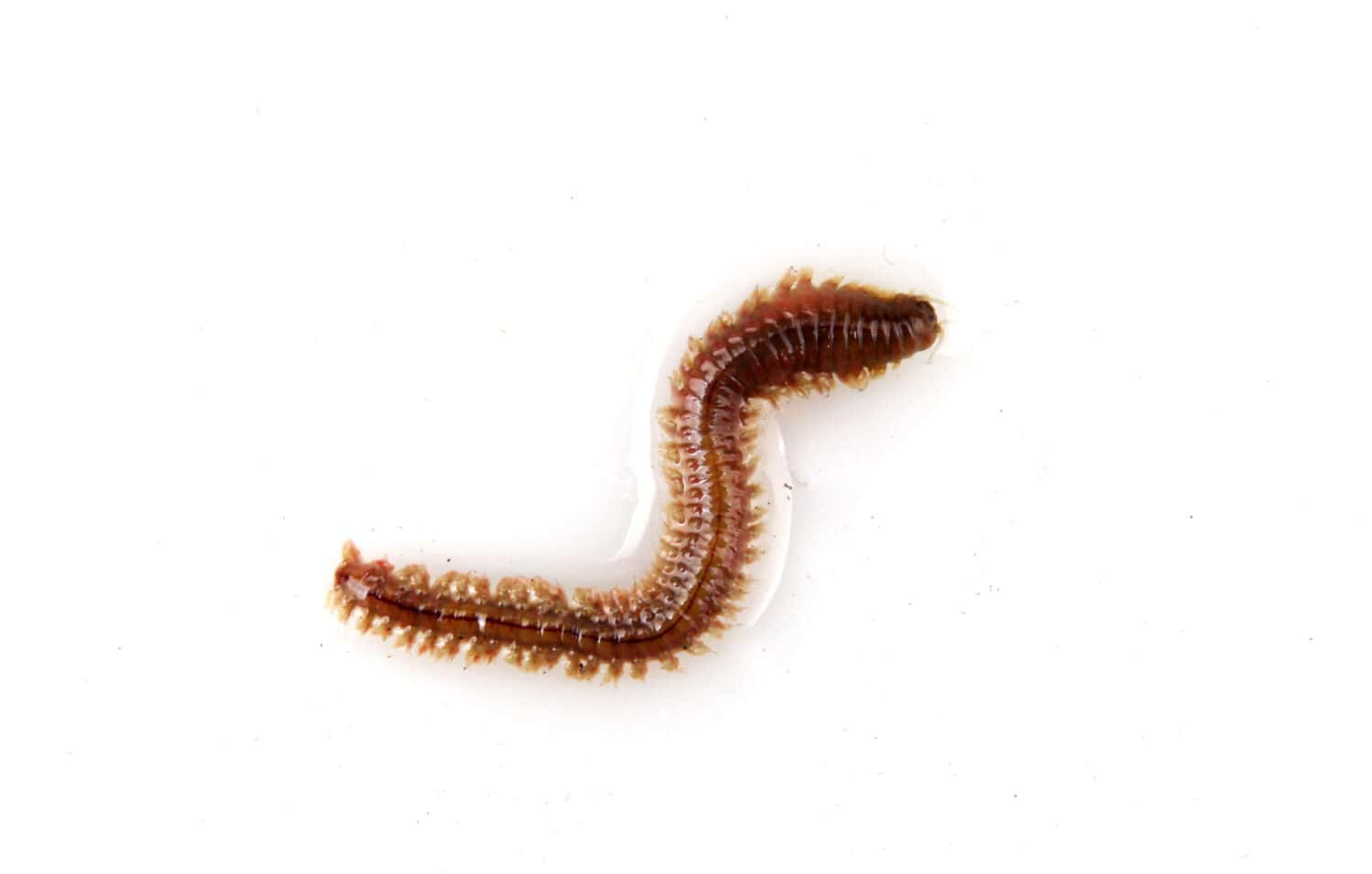
Pile worms are also called cider worms or clam worms.
©Nenov Brothers Images/Shutterstock.com
The pile worm (Alitta succinea) is another notable annelid species. Pile worms have elongated, cylindrical bodies, which can reach lengths of up to 8 inches, depending on the species. Their segmented bodies are typically reddish-brown and bear distinct setae or bristles along their sides. What distinguishes the pile worm from other annelids is its remarkable ability to construct and inhabit U-shaped burrows in sandy substrates, where it lives and forages for detritus. These burrows, reinforced with a mucous secretion, help protect the worm from predation. They also maintain a stable environment, even when subjected to tidal changes.
Where Do They Live?
Pile worms have a wide geographic distribution, primarily inhabiting temperate and subarctic coastal areas in the Northern Hemisphere. Their range includes various coastal regions from the eastern coast of North America, across the North Atlantic to the coasts of Europe, including the Baltic Sea and the North Sea. Pile worms can also live along the western coast of North America, extending from Alaska down to California. They thrive in intertidal and subtidal zones with sandy substrates, estuaries, and coastal environments, making them a common sight in these regions. Pile worms play a crucial role in the ecology of coastal ecosystems, as their burrowing activity helps mix and oxygenate sediment, promoting nutrient recycling and supporting other organisms that rely on these sandy habitats.
#4 Bobbit Worm
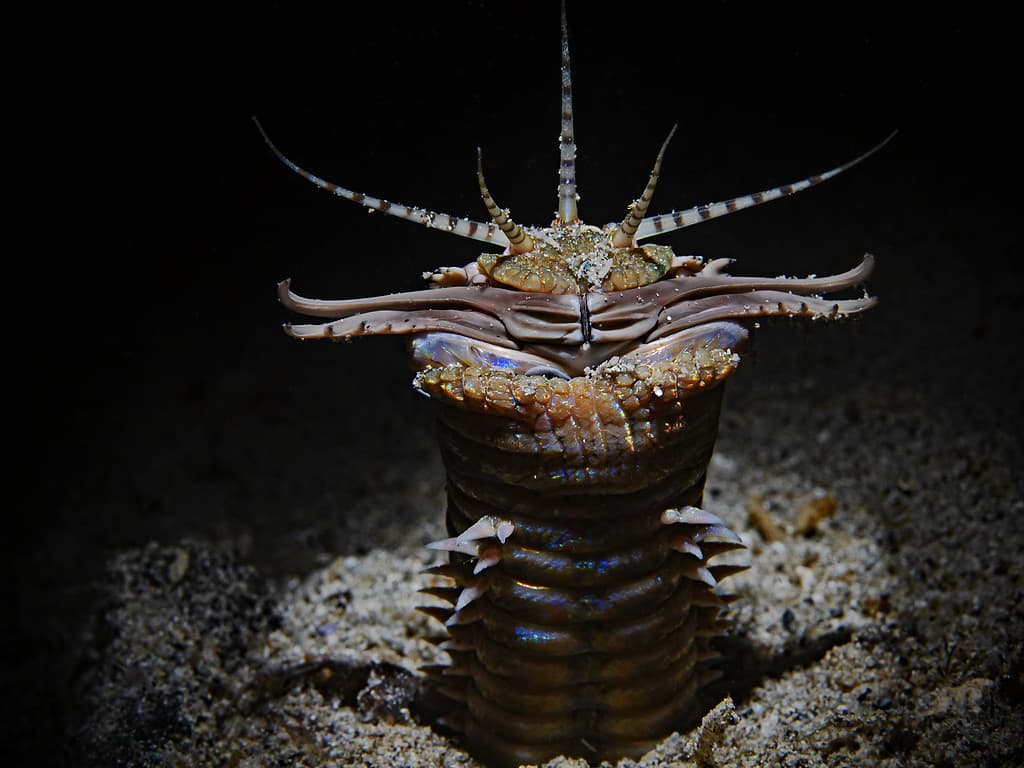
Although bobbit worms have two eyes in the front section of their head, they are almost completely blind.
©scubaluna/iStock via Getty Images
The bobbit worm, scientifically known as Eunice aphroditois, is a remarkable and enigmatic annelid species. What distinguishes the bobbit worm is its impressive size and predatory behavior. Individuals are capable of growing up to ten feet or even longer. They have elongated, segmented bodies covered in bristle-like appendages and a pair of large, powerful jaws that protrude from their burrowed lairs. These jaws, which can be several inches long, have sharp, serrated edges. This unique morphology allows the worm to ambush and capture prey, including fish and other small marine organisms. The bobbit worm’s hunting strategy, which involves striking with astonishing speed and precision from its concealed burrow, makes it a formidable predator and one of the most distinct and fascinating annelids in the ocean.
Interestingly, bobbit worms got their nickname from the famous criminal case of Lorena Bobbit and her specific actions in the attack against her husband. The name is inspired by the scissor-like jaws of the worm and its ability to cleanly cut prey in half.
Where Do They Live?
Bobbit worms primarily live throughout the warm tropical and subtropical waters of the Indo-Pacific region. They exist in a range of marine habitats, including coral reefs, sandy substrates, and rocky seabeds. While they are most associated with sandy environments, they can also inhabit coral rubble and other types of oceanic bottoms. Their presence in these diverse habitats reflects their adaptability as ambush predators, capable of lurking within their burrows, poised to strike at passing prey with their formidable jaws. The geographic distribution of bobbit worms is mainly confined to these warm, tropical waters, where their hunting strategy and distinct morphology make them a fascinating component of the marine ecosystem.
#5 Tyrant Leech King
The tyrant leech king, scientifically known as Tyrannobdella rex, is our final intriguing annelid species. Although this leech is only up to 2 inches long, it is still very intimidating. This leech is incredibly unique because of its predatory behavior and feeding mechanisms. It has a unique single jaw and eight teeth that are approximately five times as long as the closely related genus Limnatis. The tyrant leech king primarily gains sustenance from the mucous membranes of mammalian respiratory tracts such as the mucosae of the mouth, nose, and throat. They also have a history of human predation. In fact, the species was first identified from a specimen taken from a Peruvian girl’s nose in 2007.
Where Do They Live?
Tyrant leech kings live in South America in the upper reaches of the Amazon, including in Peru. The leech inhabits aquatic environments like the Amazon River. The species is a relatively recent discovery having first been officially classified in 2010. As a result, there is still more to learn about the biology and distribution of these fascinating parasites.
Honorable Mentions
The phylum Annelida boasts a wide array of fascinating and diverse species beyond those previously mentioned. Here are a few additional annelids and intriguing facts about them.
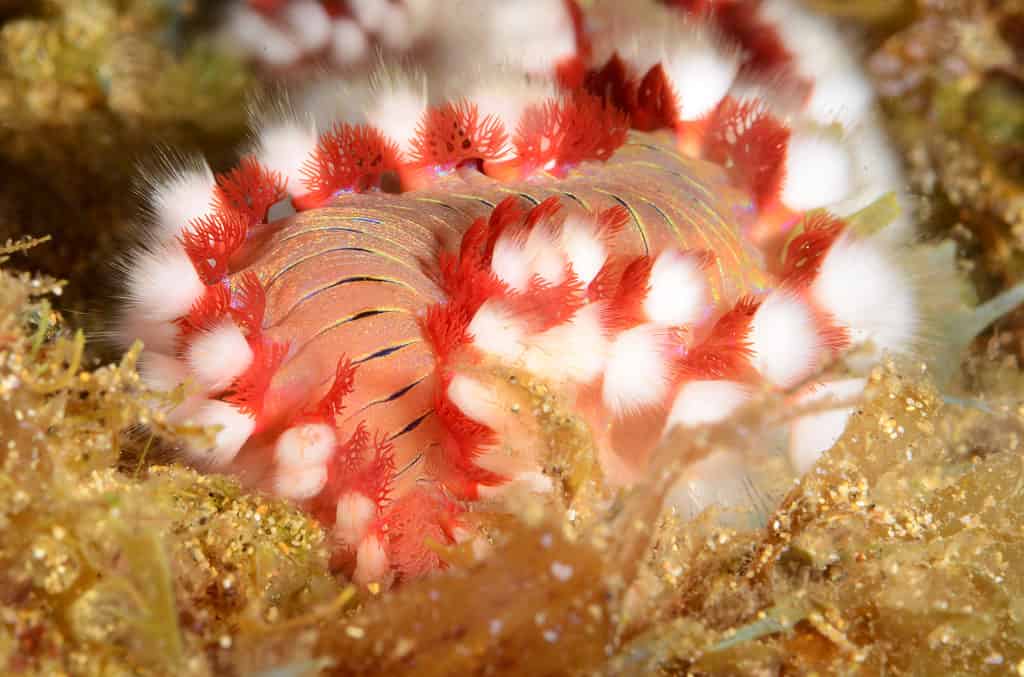
The bearded fireworm is one of many unusual-looking worms because of its bright colors and ornate bristles.
©Alexandre Ornellas/Shutterstock.com
- Fireworms: Fireworms are strikingly colorful and get their name from the stinging sensation they can inflict with their bristles, which contain a toxin. They live in tropical and subtropical seas, contributing to the vibrancy of marine ecosystems.
- Christmas Tree Worms: These beautiful, tube-dwelling worms display vibrant, spiral-shaped structures resembling Christmas trees. They are filter feeders that use their feathery appendages to capture plankton, adding a burst of color to coral reefs worldwide.
- Lugworms: Lugworms are essential in coastal ecosystems as they burrow through sediments, promoting oxygenation and nutrient cycling. They are also common fishing bait, making them ecologically and economically significant.
- Tomopteris: Tomopteris are pelagic polychaetes known for their bioluminescence. They light up the deep ocean with dazzling displays, contributing to the enchanting glow of the abyss.
- Spoon Worms: These worm-like creatures dwell in burrows beneath sandy or muddy substrates. They are unique in their lack of a true body cavity and can be found in marine environments worldwide.
Each of these annelids showcases the incredible diversity within this phylum and their significant roles in various ecosystems, from terrestrial habitats to deep-sea habitats, making them a source of fascination for biologists and nature enthusiasts alike.
The photo featured at the top of this post is © goran_safarek/Shutterstock.com
Thank you for reading! Have some feedback for us? Contact the AZ Animals editorial team.




